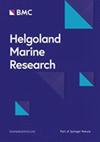An example for transatlantic hitchhiking by macrozoobenthic organisms with a research vessel
4区 地球科学
Q2 Agricultural and Biological Sciences
引用次数: 3
Abstract
In 2019 the RV Meteor cruised from Guadalupe in April/May to Cape Verde in June/July and to Namibia in August/September. The distance is about 10,000 km. The ship has a moon pool for installation of instruments. In Cape Verde we had a first glimpse of the already sparsely populated moon pool. We reached Namibian waters in mid-August. In mid-September, 47 days later and 6000 km south, the ship's moon pool was sampled in the port of Walvis Bay. 13 different taxa could be identified belonging to two phyla, four classes, six orders and 10 families. Most of these species have not yet been observed in the port or in the adjacent areas and are new records for the entire Namibian coast. The goose barnacles Conchoderma auritum (Linnaeus, 1767), Conchoderma virgatum Spengler, 1789 and Lepas anatifera Linnaeus, 1758 were particularly noticeable. They were only surpassed by the large number of amphipods. The species Ericthonius brasiliensis (Dana, 1853), Jassa marmorata Holmes, 1905, Stenothoe senegalensis Krapp-Schickel, 2015 and Paracaprella pusilla Mayer, 1890 are particularly noteworthy here. In addition, the pycnogonid species Endeis straughani Clark, 1970 and the titan acorn barnacle Megabalanus coccopoma (Darwin, 1854) should be mentioned, which occurred very frequently as well. The present study shows, on the one hand, an example of the transatlantic spread of bioinvasive species by ships as vectors and, on the other hand, a convenient method for sampling ship hulls.大型底栖动物搭乘科考船横渡大西洋的例子
2019年,RV流星号于4月/ 5月从瓜达卢佩出发,6月/ 7月前往佛得角,8月/ 9月前往纳米比亚。距离大约是1万公里。船上有一个用于安装仪器的月池。在佛得角,我们第一次看到了人烟稀少的月池。我们在八月中旬到达纳米比亚水域。9月中旬,47天后,在向南6000公里的沃尔维斯湾港采集了该船的月池样本,鉴定出13个不同的分类群,隶属于2门4纲6目10科。这些物种中的大多数尚未在港口或邻近地区观察到,并且是整个纳米比亚海岸的新记录。鹅藤壶(Conchoderma auritum, Linnaeus, 1767), Conchoderma virgatum Spengler, 1789和Lepas anatifera Linnaeus, 1758)尤其引人注目。只有数量庞大的片脚类动物超过了它们。这里特别值得注意的是Ericthonius brasiliensis (Dana, 1853), Jassa marmorata Holmes, 1905, Stenothoe senegalensis Krapp-Schickel, 2015和Paracaprella pusilla Mayer, 1890。除此之外,还需要提到的是1970年发现的巨橡子藤壶Endeis straughani Clark和1854年发现的巨橡子藤壶Megabalanus coccopoma。本研究一方面提供了生物入侵物种通过船舶作为媒介跨大西洋传播的一个例子,另一方面提供了对船体进行采样的方便方法。
本文章由计算机程序翻译,如有差异,请以英文原文为准。
求助全文
约1分钟内获得全文
求助全文
来源期刊

Helgoland Marine Research
地学-海洋学
自引率
0.00%
发文量
0
审稿时长
6-12 weeks
期刊介绍:
Helgoland Marine Research is an open access, peer reviewed journal, publishing original research as well as reviews on all aspects of marine and brackish water ecosystems, with a focus on how organisms survive in, and interact with, their environment.
The aim of Helgoland Marine Research is to publish work with a regional focus, but with clear global implications, or vice versa; research with global emphasis and regional ramifications. We are particularly interested in contributions that further our general understanding of how marine ecosystems work, and that concentrate on species’ interactions.
 求助内容:
求助内容: 应助结果提醒方式:
应助结果提醒方式:


